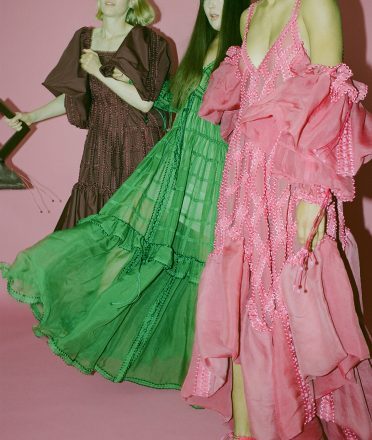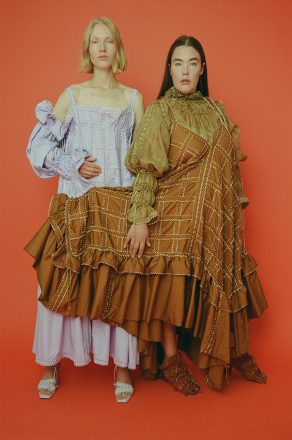Sofia Ilmonen, winner of the new sustainability prize at the Hyères festival The - Fabrics - Leather - Accessories - Première Vision Paris

Born in Finland, Sofia Ilmonen developed her very early attraction to designing and cloth-making at the London College of Fashion, where she graduated in 2014. She worked in various technical roles in fashion, such as creative pattern cutter and sewing Technician. Before moving back to Finland to accomplish an MA degree in Fashion design at Aalto University in 2018, she worked three years as a seamstress for Alexander Mcqueen.
At the 36th International Festival of Fashion, Photography and Fashion Accessories – Hyères, she won the Mercedes-Benz Sustainability prize for her collection, a demonstration of how good design can embrace all at the same time feminity, fun and ethical and sustainable values.
A few questions to dive into her design process :
Why did you choose to focus on sustainable fashion?
Clothing industry is arguably one of the largest polluting industries in the world so as a fashion designer I feel that it is my duty to rethink the practices used. Therefore sustainability has long been the driving force for my designs. Before I concentrated more on sustainable/eco- friendly materials but for this collection I wanted to approach sustainability more holistically. One essential thought on the process of creating the collection was how the concept of sustainable fashion can be seen somewhat contradictory, as fashion is about change and sustainability is about longevity and stability. Therefore the motivation for a modular & transformable concept was to offer more sustainable alternatives to meet the changing needs and tastes of the wearer over time, with less materialistic means.

Can you tell us more about your transformable collection? How did you come up with this idea?
The collection was developed over the two years of MA studies at Aalto University. It was a series of experiments and happy accidents that led to more refined module structure and concept.
The core idea of the collection ‘Same Same but Different’ lies in modular design concept which seeks to enable garments’ own longevity through the unique structure, yet uniform shape of the modules.
The silhouettes of all the collection garments are created with same sized square modules and they are assembled together with a button and loop mechanism which allows endless modifications or complete transformations on the style without sewing. This is where the collection gets its name from – the building blocks of the garment stay the same, but the form can be different with just a move of a button.
The visual inspiration from the collection was drawn from 17th and 18th century detachable clothing which could be considered as early stages of modularity. These reference points were sources of inspirations for the voluminous silhouettes and shapes and elaborate details, but also for the overall mood for the collection.
Sofia’s show at Hyères, 15th of octobre 2021
Where does your design journey start? With the textile? Or with the shape? Which one comes first?
Here the textile structure works both as a detail and function. The button&loop structure allows the square modules to be attached together and the drawstring channels allows the modules to be gathered to shape. So at same time as being the operating base of the module concept it also creates beautiful textures and details.
The development of the collection processed simultaneously with the refinement of the square module structure. Draping silhouettes gave a better idea on what was needed from the module, and at the same time working on the module components indicated what kind of functions could be achieved with the garments. So here the development of the texture and silhouette went hand-in-hand.
Where and how do you source your materials?
The main materials of the collection are organic cotton poplin and peace silk organza and they are all sourced within Europe. Some of the garments are also naturally dyed, which I absolutely love! I have mixed naturally dyed fabrics with ready dyed materials and the point there was that you cannot really tell the difference which is which as they are all vibrant.
In the future I would like to corporate more naturally dyed materials which was not possible on this collection due to time constraints.
Moreover, the colors also embody the positive energy and optimism that I want to express with the collection.
You developed some bags for your capsule collection and fitted it to the dresses – how did that come about?
The bags and shoes are made out of reindeer leather (by-product of the reindeer meat business) and plywood.
The bags are created by folding the same sized squares as used on the garments.
They are built so that they can also be taken apart and made into a new style.
The shoe soles are made by my dad who is not a shoemaker but very talented carpenter.
The shoes also follow the same idea of adjustability as the top part of the shoe can be taken off and new style can build onto it.


How should the fashion industry produce and how should the consumer consume to reduce the impact of fashion on the planet?
I believe that the future of fashion lies in systematic change, where strategic innovations create opportunities to develop completely new sustainable ways of doing business. In practice this modular clothing concept could operate through a product-service system, where the collections are created using the same module format and the customers can have their existing module garment changed into a new season style through the service.
This would aid the change towards a more circular economy from the predominant linear cycle in fashion.
Body positivity and diversity is also present in your work. Do you have a woman in mind when you design?
The woman I design is determined and going for their goals, but they are doing it with kindness towards themselves and others -I like to call it soft confidence. Due to the square module form and the function to gather the garments to fit, the clothes can fit to so many different body shapes and types, which I think is pretty amazing! We are all different so being able to highlight the unique beauty of each individual feels special.
Moreover, from the sustainability perspective the adjustable sizing can have many benefits as size related issues are one of the main reasons for garment disposal.
What’s next for you?
I have dreamt about my own brand since I was a little girl so I am aiming to launch my brand at the beginning of 2022. My plan is to stay in the modular world and develop and refine the
concept even further. The next cocollection is going to be created using the same square
modules but in a completely new way. This prospect of the concept excites me!
Follow Sofia on her Instagram and discover more of our fashion guests!
